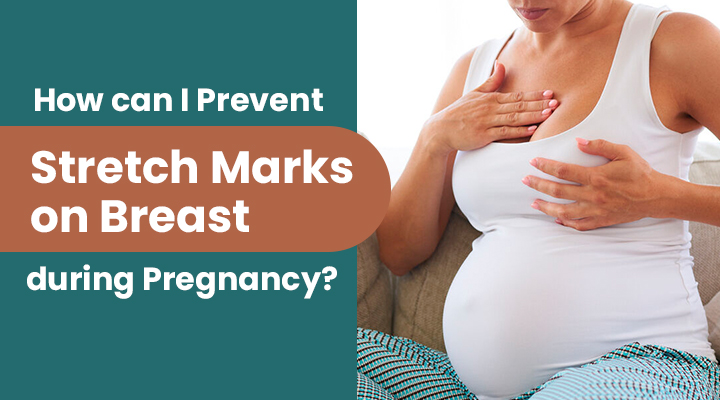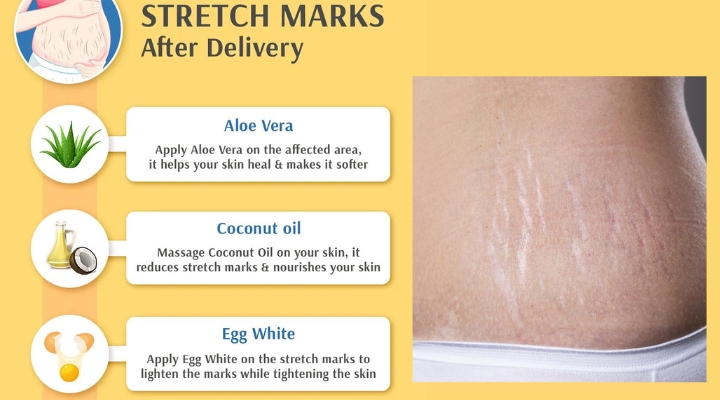How Can I Prevent Stretch Marks on Breast during Pregnancy?
Pregnancy is the happiest moment of a woman’s life but Stretch marks on the breast during pregnancy make us worried. In this article, we will explore “How Can I Prevent Stretch Marks on Breast during Pregnancy?” One of the most common concerns for expectant mothers is the development of stretch marks, and this concern often extends to the breasts. Stretch marks on breasts during pregnancy are a natural occurrence, but there are steps you can take to minimize their appearance or prevent them altogether.
Understanding Stretch Marks
Stretch marks are medically known as (striae gravidarum). During pregnancy, there are narrow streaks or lines that can develop on the surface of the skin. They are a result of the skin stretching beyond its normal capacity, causing the collagen and elastin fibers in the skin’s middle layer (dermis) to break down. As the skin stretches, it can tear slightly, leading to the formation of these marks.
Stretch marks can appear anywhere on the body where there is rapid growth or stretching of the skin. Common areas for stretch marks include the abdomen, hips, thighs, and breasts. While they are harmless and don’t pose any health risks, many people find them aesthetically displeasing and seek ways to prevent or reduce their visibility.
Why Do Stretch Marks Occur During Pregnancy?
Stretch marks during pregnancy are a result of the dramatic changes that the female body undergoes to accommodate a growing fetus. Here are some key reasons why stretch marks commonly occur during this time:
- Rapid Weight Gain- During pregnancy, women naturally gain weight to support the developing baby. The skin on the breasts, as well as other areas, stretches to accommodate this weight gain.
- Hormonal Changes- Hormonal fluctuations particularly increased levels of hormones like estrogen and relaxin, can affect the skin’s elasticity. This hormonal shift can make the skin more susceptible to stretching.
- Genetics- A person’s genetic predisposition also plays a very important role in whether or not they will develop stretch marks. If your mother or grandmother had them during their pregnancies, you may be more likely to experience them as well.
- Skin Type- Different skin types have varying levels of elasticity. Individuals with drier or less elastic skin may be more prone to developing stretch marks.
- Multiple Pregnancies- Women who have had multiple pregnancies may be at a higher risk of developing stretch marks, as their skin has already experienced stretching in previous pregnancies.
- Quick Growth of Breasts- The breasts themselves undergo significant changes during pregnancy, including increased size and development of mammary glands, which can contribute to stretch marks on the breast tissue.
Also check Intimacy During Pregnancy – Is Intimacy OK While Pregnant
Preventing Stretch Marks on Breasts during Pregnancy
Although it may not be possible to completely eliminate the risk of stretch marks, there are several strategies you can implement to reduce their appearance or prevent them from forming on your breasts during pregnancy. Here are some effective tips:
- Hydration- Keeping your skin well-hydrated is essential. Drink plenty of water to maintain skin elasticity and use a moisturizer regularly. Look for moisturizers that contain ingredients like cocoa butter, shea butter, vitamin E, or collagen-boosting peptides. Applying a moisturizer to your breasts daily can help improve skin hydration and minimize the chances of stretch marks.
- Balanced Diet- A healthy diet rich in nutrients is crucial during pregnancy. Foods high in vitamins C and E, as well as zinc, can support skin health. These nutrients help in collagen production, which is essential for skin elasticity. Include fruits, vegetables, lean proteins, and whole grains into your diet.
- Weight Management- While weight gain is a natural part of pregnancy. It aims for a slow and steady weight gain within the recommended guidelines given by your healthcare provider. If sudden and excessive weight gain can put extra pressure on the skin and increase the likelihood of stretch marks. Consult your healthcare provider for personalized weight management advice.
- Supportive Bras- Wearing a well-fitting and supportive bra can help reduce the strain on your breast tissue as it expands during pregnancy. Ensure that your bra provides proper support and does not cause any discomfort or irritation.
- Gentle Skin Care- Avoid using harsh soaps or scrubs on your breasts, as these can strip the skin of its natural oils and disrupt its barrier. Opt for mild, fragrance-free cleansers and gently pat your skin dry after washing.
- Massage- Regularly massaging your breasts with a moisturizing cream or oil can enhance blood circulation and help maintain skin elasticity. Be gentle and use circular motions to apply the product.
- Avoid Scratching- Itchy skin is common during pregnancy, but scratching can damage the skin and worsen the appearance of stretch marks. Instead, try using a cold compress or applying a moisturizer to soothe itching.
- Stay Active- Engaging in regular and low-impact exercises can promote healthy blood flow and skin elasticity. Consult with your healthcare provider to determine suitable exercises for your pregnancy stage.
- Stay Sun Safe- Protect your skin from excessive sun exposure, as UV rays can further damage stretched skin and make stretch marks more noticeable. Use sunscreen with a high SPF when going out in the sun.
- Consult a Dermatologist- If you’re concerned about stretch marks or have a family history of severe stretch marks, consider consulting a dermatologist or skincare specialist. They can recommend specific treatments or products to minimize their appearance.
Related – How To Distinguish Between False Pain & True Labor Pain
Post-Pregnancy Stretch Mark Management
If you’ve developed stretch marks on your breasts during pregnancy, don’t despair. There are several post-pregnancy treatments and interventions that can help minimize their appearance:
- Topical Treatments- Over-the-counter creams and oils that contain ingredients like retinoids, hyaluronic acid, or peptides can help fade stretch marks over time. Consult your healthcare provider before using any topical treatments, especially if you are breastfeeding.
- Prescription Medications- In some cases, a dermatologist may prescribe stronger topical treatments or medications to improve the appearance of stretch marks.
- Laser Therapy- Laser treatments, such as fractional laser therapy or pulsed dye laser therapy, can help stimulate collagen production and reduce the redness of stretch marks. These treatments should only be done by trained professionals.
- Microneedling- Microneedling involves the use of a device with tiny needles to create controlled micro-injuries in the skin. This can stimulate collagen production and improve the appearance of stretch marks.
- Chemical Peels- Chemical peels can help exfoliate the top layer of skin, potentially reducing the visibility of stretch marks. However, this should be done under the guidance of a dermatologist.
- Surgical Procedures- In severe cases, surgical procedures like abdominoplasty (tummy tuck) or mastopexy (breast lift) can be considered to remove or reduce the appearance of stretch marks, but these options are typically pursued after pregnancy when you’re no longer planning to have more children.
You can go through – 5 Effective Ways To Increase Breast Milk Supply
Embracing Your Body –
It’s important to remember that stretch marks are a common and natural part of the pregnancy journey. They are a testament to the incredible changes your body undergoes to bring new life into the world. While it’s perfectly fine to take steps to prevent or reduce stretch marks. It is equally important to embrace your changing body and be proud of the journey you are on.
Remember that your body’s appearance does not define your worth as a mother or as a person. Your focus during pregnancy should primarily be on your health and the health of your baby. Take care of your skin, stay hydrated, eat well, and consult with healthcare professionals for guidance throughout your pregnancy.
At last, stretch marks on breasts during pregnancy are a common occurrence due to the natural changes your body undergoes. While they may not be entirely preventable, you can take proactive steps to reduce their appearance or prevent them from forming. Except for the changes your body goes through during this remarkable time, and remember that you are creating a new life. Whether you develop stretch marks or not, your body is a testament to the beauty of motherhood.










